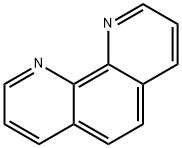
1,10-Phenanthroline anhydrate
- CAS No. :66-71-7
- Molecular Formula:C12H8N2
- Purity:
- Molecular Weight:180.2g/mol
Product Details
Factory supply 1,10-Phenanthroline anhydrate 66-71-7 with sufficient production capacity
CODE:km-089
Product Name: 1,10-Phenanthroline anhydrate
CAS:66-71-7
Assay: 99% min.(AR)
Dissolution test in ethanol: qualified
Residue on ignition ( as Sulfate) : 0.1% max.
UN No. 2811, hazard class: 6.1 PKG: III
Package:25kg/fiber drum
1,10-Phenanthroline anhydrate, is an important organic ligand commonly used as a chromogenic agent for metal ions in analytical chemistry. It can form stable complexes with various metal ions and is commonly used for detecting and quantifying the presence of certain metal ions. 1,10-Phenanthroline anhydrous compounds also have applications in organic synthesis, especially in the synthesis of compounds with fluorescent properties.
Wuhan Kemi-Works Chemical Co., Ltd. is specialized in the R&D, production and sale of Special fine chemicals organic silicone chemicals, organic fluoro chemicals, Fluorosilicone chemicals, electroplating chemicals, OLED intermediates and chemical indicators. Widely used in pharmaceutical, pesticide, OLED, electronics, electroplating, organic synthesis and other fields. Our business mainly focus on the conventional products, complemented by custom chemical production, we can accept the client's request, providing services such as structural analysis, research synthesis route and standard samples. We have set up R&D center, quality inspection center and manufacturing site in Hubei and Zhejiang. We have professional sales team, focus on quality and service, and we have achieved excellent performance over the years. Our company is committed to the development of international markets , our products are mainly exported to many countries and regions, such as Europe, America, South-east Asia, the Middle East and Africa etc.
1,10-Phenanthroline anhydrate is a chelating agent that forms stable complexes with divalent metal ions like iron (Fe²⁺), nickel (Ni²⁺), ruthenium (Ru²⁺), and silver (Ag⁺). It is particularly known for forming a complex with Fe²⁺ called ferroin, which is used as an indicator in Fe²⁺ salt titrations. It acts as an inhibitor of metallopeptidases (especially carboxypeptidase A) by chelating the metal ion required for catalytic activity, preventing enzymatic function.
| Safety and Hazards | |
|---|---|
| Toxicity | Toxic if swallowed: Can cause damage to organs through prolonged or repeated exposure. Very toxic to aquatic life: Harmful to the environment if released in large quantities. |
| Handling Precautions | Avoid skin contact: Wash thoroughly after handling. Avoid ingestion: Do not eat, drink, or smoke while using this chemical. Environmental Precautions: Take measures to avoid releasing it into the environment due to its toxicity to aquatic life. |





